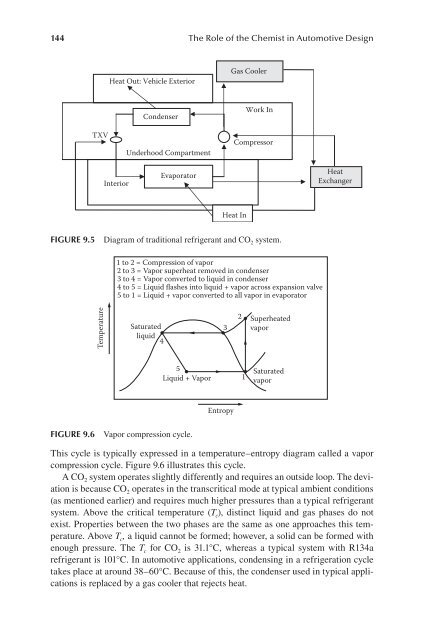THE ROLE OF THE
THE ROLE OF THE
THE ROLE OF THE
You also want an ePaper? Increase the reach of your titles
YUMPU automatically turns print PDFs into web optimized ePapers that Google loves.
144 The Role of the Chemist in Automotive Design<br />
TXV<br />
Heat Out: Vehicle Exterior<br />
Interior<br />
Condenser<br />
Underhood Compartment<br />
Evaporator<br />
Gas Cooler<br />
Heat In<br />
Work In<br />
Compressor<br />
FIgure 9.5 Diagram of traditional refrigerant and CO 2 system.<br />
Temperature<br />
1 to 2 = Compression of vapor<br />
2 to 3 = Vapor superheat removed in condenser<br />
3 to 4 = Vapor converted to liquid in condenser<br />
4 to 5 = Liquid flashes into liquid + vapor across expansion valve<br />
5 to 1 = Liquid + vapor converted to all vapor in evaporator<br />
Saturated<br />
liquid<br />
4<br />
5<br />
Liquid + Vapor<br />
FIgure 9.6 Vapor compression cycle.<br />
Entropy<br />
Heat<br />
Exchanger<br />
This cycle is typically expressed in a temperature–entropy diagram called a vapor<br />
compression cycle. Figure 9.6 illustrates this cycle.<br />
A CO 2 system operates slightly differently and requires an outside loop. The deviation<br />
is because CO 2 operates in the transcritical mode at typical ambient conditions<br />
(as mentioned earlier) and requires much higher pressures than a typical refrigerant<br />
system. Above the critical temperature (T c), distinct liquid and gas phases do not<br />
exist. Properties between the two phases are the same as one approaches this temperature.<br />
Above T c, a liquid cannot be formed; however, a solid can be formed with<br />
enough pressure. The T c for CO 2 is 31.1°C, whereas a typical system with R134a<br />
refrigerant is 101°C. In automotive applications, condensing in a refrigeration cycle<br />
takes place at around 38–60°C. Because of this, the condenser used in typical applications<br />
is replaced by a gas cooler that rejects heat.<br />
3<br />
2<br />
1<br />
Superheated<br />
vapor<br />
Saturated<br />
vapor







